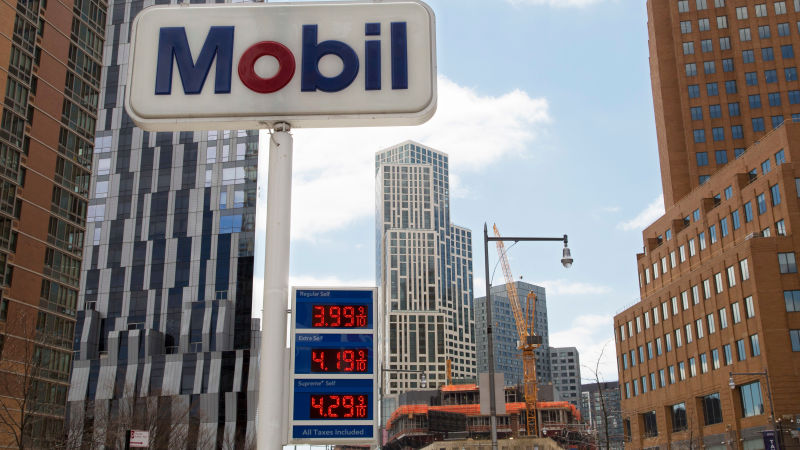
With gas prices hitting a three-year high and projected to keep rising, us Americans are going to take a hit every time we fill up our flashy new SUVs and crossovers we’re all buying. But there’s a counterargument that today’s vehicles offset rising gas prices with higher fuel efficiency. But are they efficient enough to “break even” with more expensive gas? We did some math to find out.
This has been coming up a lot as American carbuyers go completely mad for crossovers and trucks and small cars fall to the wayside. Ford went as far as killing all of its cars in America. Welcome, as ever, to the sedanocalypse. Some people don’t think this will be all that bad, but the math doesn’t always back that up.
For this experiment, we looked at gas prices over the years as well as the fuel economy figures of two representative vehicles: the Ford F-150, the best selling vehicle in the country for the last bazillion years and the Honda CR-V, a good middle-of-the-road crossover like we all love buying these days. Technically, the Nissan Rogue outsells the Honda at the moment, but it hasn’t been around that many years. We were not cursed with the Rogue back in 2003. Simpler times.
Advertisement
The first fun year to compare our current gas situation with is 2003, a kind of barometer for the pre-Recession cheap gas days. The Hummer H2’s best selling year was 2003, which makes it a kind of spiritual peak.
For our control vehicle, let’s look at the base-model Ford F-150, which has made huge strides in fuel economy since it went aluminum a few years ago.
To help organize our data, A Chart:
Advertisement
The price of one gallon of regular in 2003 came to $1.56 (lol), according to Statista. We were going to use the U.S. government’s figures for gas prices, but it charts all grades of gas combined while Statista let us track regular alone, which seemed more fair.
OK, so a Ford F-150 from 2003 had a 25-gallon tank and a combined city/highway mileage estimate of 16 mpg. This meant that a fill up of your new ‘03 Ford would have cost you $39 at the time, and you wouldn’t have to fill up for another 400 miles. At 16 mpg, you’d burn up 6.25 gallons to go 100 miles, or $9.75 for every 100 miles you drive.
How does this compare to a current Ford F-150? A few things get changed. The cost for a gallon of regular as of the day of this writing is $2.90, according to AAA. The now-lightweight 2018 Ford F-150 has a smaller gas tank of 23 gallons, but it also has an improved combined mileage estimate of 21 mpg. Of course, because gas is now more expensive, it’ll cost $66.70 to fill the tank, and you won’t need to dump that much cash down the drain for another 483 miles. That comes down to 4.76 gallons or $13.80 for ever 100 miles you drive.
Advertisement
This is the interesting stuff. The F-150 has grown more efficient in 15 years’ time, but it has not offset the rise in gas prices. You’re still paying more at the pump with your more efficient F-150 today than with your gas-guzzling F-150 back in 2003, bumping Linkin Park.
Things follow a similar path for the Honda CR-V, which has climbed from 23 mpg in 2003 to a lofty 28 in 2018. In spite of the added fuel efficiency, it costs more to fill up today ($23.87 vs $40.67) and more for every 100 miles you drive ($7.09 s $10.42.)
We also plugged in numbers for a couple other years including 2008 (a real high point for gas prices, spiking up to $3.25 across the year and nation as a whole) and 2009 (when gas prices dropped down to $2.35 before they climbed up to a record 2012 high of $3.62). In both of those years, gas mileage was low enough and gas prices high enough that it is cheaper to drive around today’s more efficient cars. But if you look at where we are historically, we’re actually climbing right up to where 2008 was.
Advertisement
If you plug in 2008 gas prices into our current fuel economy figures, kind of like what we could expect to see at the pump within a year, it’s basically going to cost you another five or 10 bucks per fill up. To put it in perspective, it’d be like if your current 2018 F-150 dropped to under 19 miles per gallon, down from 21. It’d be the same if your current 2018 CR-V dropped to 25 mpg from 28. The gains of efficiency we’ve been happy to see from carmakers are going to get effectively washed away.
Is that convoluted? OK, that’s kind of convoluted. The point is that while today’s cars are more efficient than they were in the days of cheap gas, today’s gas prices have largely if not completely offset those gains and it’s looking worse from here. There’s little to say that we won’t still be hurting at the pump with better-mpg vehicles just like we were in the days of really high prices.
We’d also like you to note that this isn’t completely comprehensive math. For the sake of simplicity, we didn’t work in variables like miles people drove year by year, exactly how fleet mileage went up or down year by year or how the Earth’s rotation would affect tires. This was a basic exercise, conducted with a few variables and even more basic math to create a sketch of how this all has played out for America.













